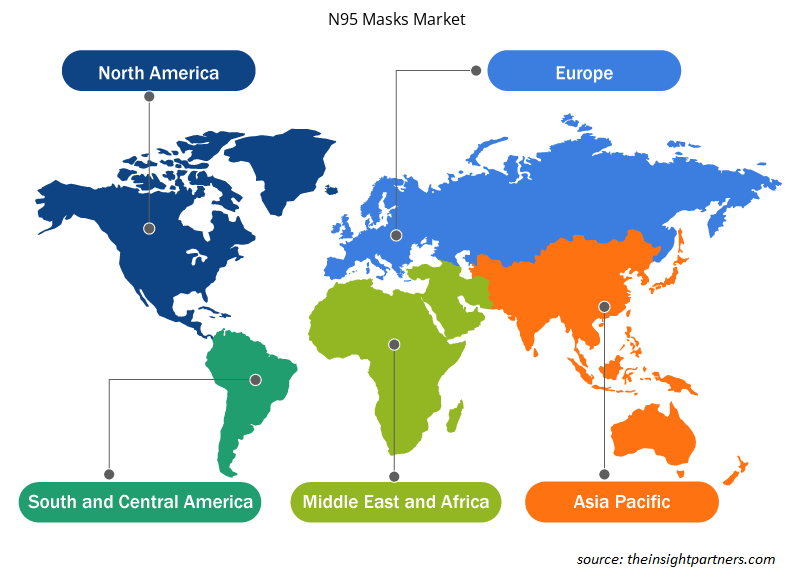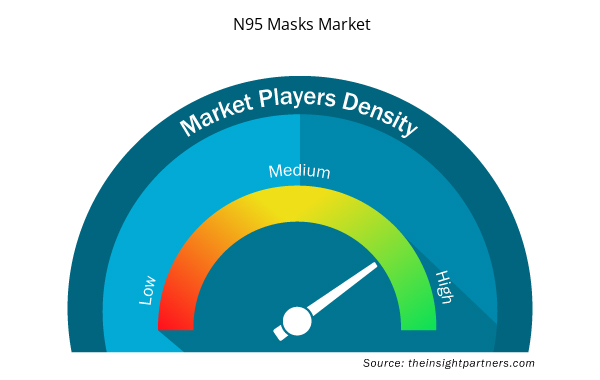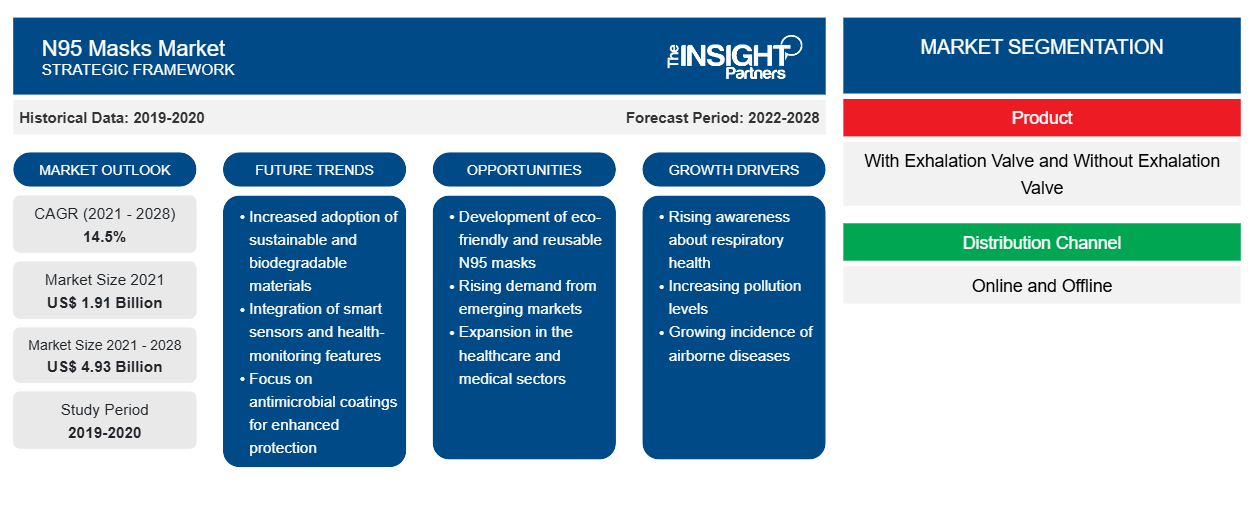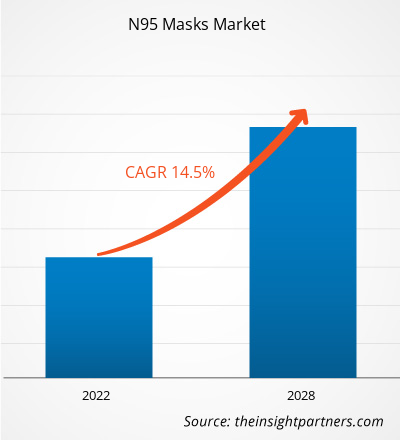Der Markt für N95-Masken soll von 1.914,54 Millionen US-Dollar im Jahr 2021 auf 4.925,80 Millionen US-Dollar im Jahr 2028 anwachsen; für den Zeitraum von 2021 bis 2028 wird eine durchschnittliche jährliche Wachstumsrate (CAGR) von 14,5 % erwartet.
Gesichtsmasken sind eine besondere Art persönlicher Schutzausrüstung, die die Belastung der Atemwege des Trägers durch gefährliche Substanzen wie giftige Chemikalien oder infektiöse Partikel verringern soll. N95-Masken können mindestens 95 % der in der Luft befindlichen Partikel mit einer Größe von mehr als 2,5 Mikrometer blockieren, darunter Partikel oder Tröpfchen, die Viren und Bakterien übertragen, und schützen so Menschen vor Infektionen und Erkrankungen der Atemwege.
Der Bericht bietet Einblicke und eine eingehende Analyse des N95-Maskenmarktes und legt dabei den Schwerpunkt auf verschiedene Parameter wie Markttrends, technologische Fortschritte, Marktdynamik und Wettbewerbslandschaftsanalysen führender Marktteilnehmer auf der ganzen Welt. Er umfasst auch die Auswirkungen der COVID-19-Pandemie auf den Markt in allen Regionen. Während der Pandemie ist die Nachfrage nach N95-Masken in den Regionen enorm gestiegen. Um den Mangel zu beheben, haben Aufsichtsbehörden wie die USFDA überarbeitete Richtlinien bezüglich der PSA herausgegeben. Die Behörde hat die Produktzulassungsverfahren liberalisiert, um eine frühzeitige Produktverfügbarkeit auf dem Markt zu ermöglichen. Verschiedene Marktteilnehmer aus Nicht-Gesundheitsunternehmen sind an der Produktion der Krankenhauskittel beteiligt, um die hohe Nachfrage zu decken. Die bestehenden Akteure steigern die Produktion und Lieferkette für die Krankenhauskittel in der Region. Im aktuellen Szenario werden jedoch verschiedene gefälschte N95-Masken der Markenunternehmen vermarktet. Die Regierung hat diesbezüglich eine Warnung herausgegeben. Beispielsweise hat Health Canada eine Warnung bezüglich gefälschter 3M N95-Atemschutzmasken/-masken herausgegeben. COVID-19 hat einen positiven Einfluss auf den N95-Maskenmarkt in der Region. Der N95-Maskenmarkt ist nach Produkt, Vertriebskanal, Endverbraucher und Region segmentiert. Der Markt ist nach Regionen segmentiert in Nordamerika, Europa, Asien-Pazifik, Naher Osten und Afrika sowie Süd- und Mittelamerika.
Passen Sie diesen Bericht Ihren Anforderungen an
Sie erhalten kostenlose Anpassungen an jedem Bericht, einschließlich Teilen dieses Berichts oder einer Analyse auf Länderebene, eines Excel-Datenpakets sowie tolle Angebote und Rabatte für Start-ups und Universitäten.
- Holen Sie sich die wichtigsten Markttrends aus diesem Bericht.Dieses KOSTENLOSE Beispiel umfasst eine Datenanalyse von Markttrends bis hin zu Schätzungen und Prognosen.
Markteinblicke
Prävalenz von COVID-19
COVID-19 ist eine ansteckende Krankheit, die über die Nasen- und Mundhöhle übertragen wird. Seit seinem Auftreten hat der Erreger SARS-CoV-2 mehrere Mutationen durchlaufen, was die Schwere der COVID-19-Pandemie noch verstärkt hat. Schon in der Anfangsphase dieser Krise haben die Weltgesundheitsorganisation (WHO) sowie Gesundheitsbehörden vieler Länder medizinisches Personal und die breite Öffentlichkeit angewiesen, Gesichtsmasken zu tragen, die die Wahrscheinlichkeit einer Virusübertragung von infizierten Personen oder Trägern auf gesunde Bevölkerungen verringern. Daher ist die Nachfrage nach Masken seit 2020 exponentiell gestiegen. Regierungen und Aufsichtsbehörden bestehen auf der kontinuierlichen Verwendung von Masken an öffentlichen Orten. Infolgedessen ist auch die Nachfrage nach N95-Masken gestiegen. Laut COVID-19-Tracker-Daten der Centers for Disease and Control (CDC) beträgt die 7-Tage-Fallrate pro 100.000 Einwohner am 17. August 2021 270,6, und in den USA wurden über 113.993 neue Fälle gemeldet. Darüber hinaus erreichte die Gesamtzahl der COVID-19-Fälle im Europäischen Wirtschaftsraum (EWR) am 12. August 2021 laut dem Europäischen Zentrum für die Prävention und Kontrolle von Krankheiten ~35.381.520.Centre for Disease Prevention and Control, as of August 12, 2021, the total count of COVID-19 cases reached ~35,381,520 in the European Economic Area (EEA).
Produktbasierte Einblicke
Basierend auf dem Produkt ist der Markt für N95-Masken in Masken ohne Ausatemventil und Masken mit Ausatemventil unterteilt. Im Jahr 2021 wird das Segment ohne Ausatemventil voraussichtlich einen größeren Marktanteil haben, während das Segment mit Ausatemventil im Prognosezeitraum voraussichtlich eine höhere durchschnittliche jährliche Wachstumsrate aufweisen wird. Das Wachstum dieses Segments ist auf die hohe Wirksamkeit des Schutzes beim Ein- und Ausatmen zurückzuführen. Verschiedene Regierungsstellen wie die WHO, die CDC und Gesundheitsministerien in mehreren Ländern fördern die Verwendung solcher Masken, um die Ausbreitung des Virus durch eine infizierte Person zu verhindern.
Einblicke basierend auf Vertriebskanälen
Basierend auf den Vertriebskanälen ist der Markt für N95-Masken in Offline und Online unterteilt. Das Offline-Segment wird 2021 einen größeren Marktanteil haben. Es wird jedoch geschätzt, dass das Online-Segment im Prognosezeitraum eine höhere durchschnittliche jährliche Wachstumsrate (CAGR) auf dem Markt verzeichnen wird.
Endbenutzerbasierte Erkenntnisse
Basierend auf dem Endverbraucher ist der Markt für N95-Masken in Bauwesen, Fertigung, Gesundheitswesen, Bergbau, Öl und Gas und andere unterteilt. Das Bausegment würde im Jahr 2021 den größten Marktanteil halten, während das Gesundheitssegment im Prognosezeitraum voraussichtlich die höchste durchschnittliche jährliche Wachstumsrate auf dem Markt verzeichnen wird.
Die Akteure auf dem Markt für N95-Masken verfolgen organische Strategien wie Produkteinführung und -erweiterung, um ihre Präsenz und ihr Produktportfolio weltweit zu erweitern und der steigenden Nachfrage gerecht zu werden.
N95-Masken Markt Regionale Einblicke
Die regionalen Trends und Faktoren, die den Markt für N95-Masken während des gesamten Prognosezeitraums beeinflussen, wurden von den Analysten von Insight Partners ausführlich erläutert. In diesem Abschnitt werden auch die Marktsegmente und die Geografie für N95-Masken in Nordamerika, Europa, im asiatisch-pazifischen Raum, im Nahen Osten und Afrika sowie in Süd- und Mittelamerika erörtert.

- Holen Sie sich die regionalen Daten für den N95-Maskenmarkt
Umfang des Marktberichts zu N95-Masken
| Berichtsattribut | Details |
|---|---|
| Marktgröße im Jahr 2021 | 1,91 Milliarden US-Dollar |
| Marktgröße bis 2028 | 4,93 Milliarden US-Dollar |
| Globale CAGR (2021 - 2028) | 14,5 % |
| Historische Daten | 2019-2020 |
| Prognosezeitraum | 2022–2028 |
| Abgedeckte Segmente | Nach Produkt
|
| Abgedeckte Regionen und Länder | Nordamerika
|
| Marktführer und wichtige Unternehmensprofile |
|
Marktteilnehmerdichte: Der Einfluss auf die Geschäftsdynamik
Der Markt für N95-Masken wächst rasant, angetrieben durch die steigende Nachfrage der Endnutzer aufgrund von Faktoren wie sich entwickelnden Verbraucherpräferenzen, technologischen Fortschritten und einem größeren Bewusstsein für die Vorteile des Produkts. Mit steigender Nachfrage erweitern Unternehmen ihr Angebot, entwickeln Innovationen, um die Bedürfnisse der Verbraucher zu erfüllen, und nutzen neue Trends, was das Marktwachstum weiter ankurbelt.
Die Marktteilnehmerdichte bezieht sich auf die Verteilung der Firmen oder Unternehmen, die in einem bestimmten Markt oder einer bestimmten Branche tätig sind. Sie gibt an, wie viele Wettbewerber (Marktteilnehmer) in einem bestimmten Marktraum im Verhältnis zu seiner Größe oder seinem gesamten Marktwert präsent sind.
Die wichtigsten auf dem Markt für N95-Masken tätigen Unternehmen sind:
- 3M
- Kimberly-Clark Corporation
- Medline Industries, Inc.
- Cardinal Health Inc
- Ansell Limited
Haftungsausschluss : Die oben aufgeführten Unternehmen sind nicht in einer bestimmten Reihenfolge aufgeführt.

- Überblick über die wichtigsten Akteure auf dem N95-Maskenmarkt
Nach Produkt
- Ohne Ausatemventil
- Mit Ausatemventil
Nach Vertriebskanal
- Offline
- Online
Nach Endbenutzer
- Konstruktion
- Herstellung
- Gesundheitspflege
- Bergbau, Öl und Gas
- Sonstiges
Von
Geographie
Nordamerika
- UNS
- Kanada
- Mexiko
Europa
- Frankreich
- Deutschland
- Italien
- Vereinigtes Königreich
- Spanien
- Restliches Europa
Asien-Pazifik (APAC)
- China
- Indien
- Südkorea
- Japan
- Australien
- Restlicher Asien-Pazifik-Raum
Naher Osten und Afrika (MEA)
- Südafrika
- Saudi-Arabien
- Vereinigte Arabische Emirate
- Rest von MEA
Süd- und Mittelamerika (SCAM)
- Brasilien
- Argentinien
- Rest von SCAM
Firmenprofile
- 3M
- Kimberly-Clark Corporation
- Medline Industries, Inc.
- Cardinal Health Inc
- Ansell Limited
- ALPHA PRO TECH, LTD.
- Honeywell International Inc.
- Die Gerson Company
- Medisca Inc
- Moldex-Metrisch
- Historische Analyse (2 Jahre), Basisjahr, Prognose (7 Jahre) mit CAGR
- PEST- und SWOT-Analyse
- Marktgröße Wert/Volumen – Global, Regional, Land
- Branche und Wettbewerbsumfeld
- Excel-Datensatz



Report Coverage
Revenue forecast, Company Analysis, Industry landscape, Growth factors, and Trends

Segment Covered
This text is related
to segments covered.

Regional Scope
North America, Europe, Asia Pacific, Middle East & Africa, South & Central America

Country Scope
This text is related
to country scope.
Häufig gestellte Fragen
Based on product, the N95 masks market is segmented into without exhalation valve and with exhalation valve. In 2021, without exhalation valve segment accounted for the highest share of the market. The demand for N95 masks without an exhalation valve is expected to grow significantly owing to the high efficiency of protection provided during inhalation and exhalation. Various government bodies, such as the WHO, the CDC, and health ministries across several countries are encouraging the usage of such masks to prevent the spread of the virus from an infected individual to the community.
N95 masks are widely used in a wide range of industries, including pharmaceuticals, biotechnology, healthcare, construction, manufacturing, mining, and oil & gas. These masks are capable of preventing the entry of micron-size particles and organisms into the human respiratory system and oral cavity.
The growth of the market is attributed to prevalence of COVID-19 and increasing investments and initiatives by market players and governments. However, the availability of alternate products hinders the market growth.
Trends and growth analysis reports related to Consumer Goods : READ MORE..
The List of Companies - N95 Masks Market
- 3M
- Kimberly-Clark Corporation
- Medline Industries, Inc.
- Cardinal Health Inc
- Ansell Limited
- ALPHA PRO TECH, LTD.
- Honeywell International Inc.
- The Gerson Company
- Medisca Inc
- Moldex-Metric
The Insight Partners performs research in 4 major stages: Data Collection & Secondary Research, Primary Research, Data Analysis and Data Triangulation & Final Review.
- Data Collection and Secondary Research:
As a market research and consulting firm operating from a decade, we have published and advised several client across the globe. First step for any study will start with an assessment of currently available data and insights from existing reports. Further, historical and current market information is collected from Investor Presentations, Annual Reports, SEC Filings, etc., and other information related to company’s performance and market positioning are gathered from Paid Databases (Factiva, Hoovers, and Reuters) and various other publications available in public domain.
Several associations trade associates, technical forums, institutes, societies and organization are accessed to gain technical as well as market related insights through their publications such as research papers, blogs and press releases related to the studies are referred to get cues about the market. Further, white papers, journals, magazines, and other news articles published in last 3 years are scrutinized and analyzed to understand the current market trends.
- Primary Research:
The primarily interview analysis comprise of data obtained from industry participants interview and answers to survey questions gathered by in-house primary team.
For primary research, interviews are conducted with industry experts/CEOs/Marketing Managers/VPs/Subject Matter Experts from both demand and supply side to get a 360-degree view of the market. The primary team conducts several interviews based on the complexity of the markets to understand the various market trends and dynamics which makes research more credible and precise.
A typical research interview fulfils the following functions:
- Provides first-hand information on the market size, market trends, growth trends, competitive landscape, and outlook
- Validates and strengthens in-house secondary research findings
- Develops the analysis team’s expertise and market understanding
Primary research involves email interactions and telephone interviews for each market, category, segment, and sub-segment across geographies. The participants who typically take part in such a process include, but are not limited to:
- Industry participants: VPs, business development managers, market intelligence managers and national sales managers
- Outside experts: Valuation experts, research analysts and key opinion leaders specializing in the electronics and semiconductor industry.
Below is the breakup of our primary respondents by company, designation, and region:

Once we receive the confirmation from primary research sources or primary respondents, we finalize the base year market estimation and forecast the data as per the macroeconomic and microeconomic factors assessed during data collection.
- Data Analysis:
Once data is validated through both secondary as well as primary respondents, we finalize the market estimations by hypothesis formulation and factor analysis at regional and country level.
- Macro-Economic Factor Analysis:
We analyse macroeconomic indicators such the gross domestic product (GDP), increase in the demand for goods and services across industries, technological advancement, regional economic growth, governmental policies, the influence of COVID-19, PEST analysis, and other aspects. This analysis aids in setting benchmarks for various nations/regions and approximating market splits. Additionally, the general trend of the aforementioned components aid in determining the market's development possibilities.
- Country Level Data:
Various factors that are especially aligned to the country are taken into account to determine the market size for a certain area and country, including the presence of vendors, such as headquarters and offices, the country's GDP, demand patterns, and industry growth. To comprehend the market dynamics for the nation, a number of growth variables, inhibitors, application areas, and current market trends are researched. The aforementioned elements aid in determining the country's overall market's growth potential.
- Company Profile:
The “Table of Contents” is formulated by listing and analyzing more than 25 - 30 companies operating in the market ecosystem across geographies. However, we profile only 10 companies as a standard practice in our syndicate reports. These 10 companies comprise leading, emerging, and regional players. Nonetheless, our analysis is not restricted to the 10 listed companies, we also analyze other companies present in the market to develop a holistic view and understand the prevailing trends. The “Company Profiles” section in the report covers key facts, business description, products & services, financial information, SWOT analysis, and key developments. The financial information presented is extracted from the annual reports and official documents of the publicly listed companies. Upon collecting the information for the sections of respective companies, we verify them via various primary sources and then compile the data in respective company profiles. The company level information helps us in deriving the base number as well as in forecasting the market size.
- Developing Base Number:
Aggregation of sales statistics (2020-2022) and macro-economic factor, and other secondary and primary research insights are utilized to arrive at base number and related market shares for 2022. The data gaps are identified in this step and relevant market data is analyzed, collected from paid primary interviews or databases. On finalizing the base year market size, forecasts are developed on the basis of macro-economic, industry and market growth factors and company level analysis.
- Data Triangulation and Final Review:
The market findings and base year market size calculations are validated from supply as well as demand side. Demand side validations are based on macro-economic factor analysis and benchmarks for respective regions and countries. In case of supply side validations, revenues of major companies are estimated (in case not available) based on industry benchmark, approximate number of employees, product portfolio, and primary interviews revenues are gathered. Further revenue from target product/service segment is assessed to avoid overshooting of market statistics. In case of heavy deviations between supply and demand side values, all thes steps are repeated to achieve synchronization.
We follow an iterative model, wherein we share our research findings with Subject Matter Experts (SME’s) and Key Opinion Leaders (KOLs) until consensus view of the market is not formulated – this model negates any drastic deviation in the opinions of experts. Only validated and universally acceptable research findings are quoted in our reports.
We have important check points that we use to validate our research findings – which we call – data triangulation, where we validate the information, we generate from secondary sources with primary interviews and then we re-validate with our internal data bases and Subject matter experts. This comprehensive model enables us to deliver high quality, reliable data in shortest possible time.


 Holen Sie sich ein kostenloses Muster für diesen Bericht
Holen Sie sich ein kostenloses Muster für diesen Bericht